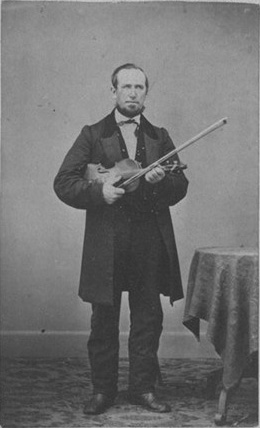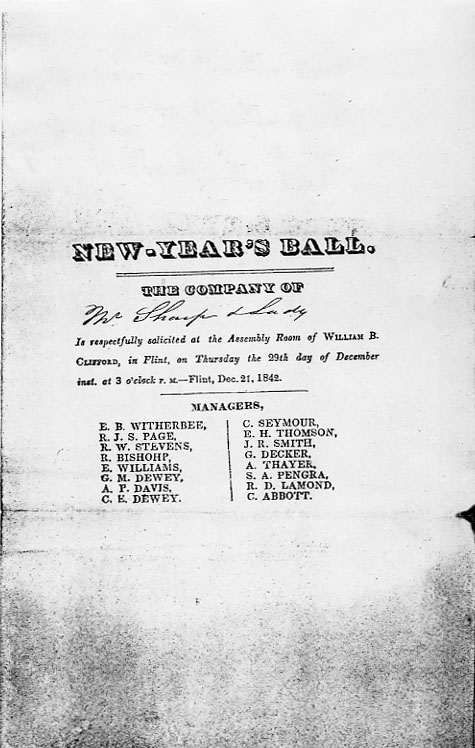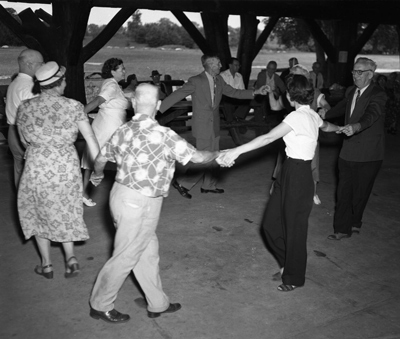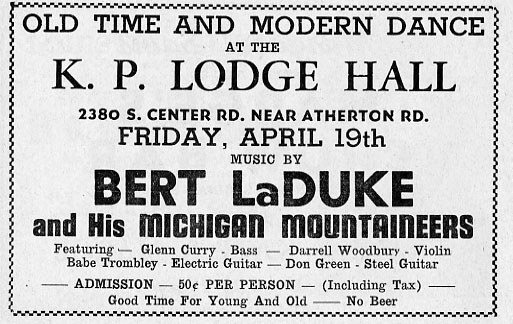A VERY BRIEF HISTORY OF FIDDLING IN MICHIGAN
As elsewhere in North America, fiddling has a history in Michigan almost as long as European-derived people have lived in the state. In recent years, through informal "jamborees" and the like, fiddling has witnessed a comeback. Today it is a state with one of the more active traditional and dance fiddling scenes in the country. Sir William Johnson reported that he attended a ball in Detroit in 1760, and we can be assured that a fiddler played there. French settlers along the Detroit River were so fond of fiddling and dancing that in 1819, the Catholic bishop of the region decided that "the people's inordinate love of social pleasures, evening gatherings and dances, was the cause of their immorality, idleness and extreme poverty" and consequently forbade balls and ordered priests to refuse to give absolution unless the penitent promised to forego these gatherings. This order seems to have had little effect. The opening of the Erie Canal in 1824 led to thousands of settlers, mostly from western New York State, seeking farmland in southern Michigan. They brought the country dances that they favored, like "Money Musk" and "Opera Reel." At the same time, dancing masters introduced cotillions, the forerunner of square dances; in the 1850s, they were still new in some places. James Swan (1824-1909) arrived in Ingham County from New York with the ability to call cotillions, and he claimed to introduce them in 1852 to rural Michigan at a ball at a hotel near Mason, while at the same time, at another hotel, a fiddler there played only old-fashioned country (contra) dances. 
(courtesy of Cherri Timmer) Formal balls were a regular feature of towns in the pioneer period. These were held typically on holidays----Thanksgiving, Christmas, Washington's Birthday, and especially at New Year's and on the 4th of July. A committee of eligible young men would arrange for the musicians and send out invitations (see illustration). 
The managers were all members of the local elite. (courtesy of Whaley Historical House) The musicians might travel far distances to play. A number of fiddlers (who often acted as dancing masters as well, running a circuit of classes in different locations a week apart) led cotillion bands that played at such balls. In Detroit and in certain other towns, these were likely to be black, like Obadiah Wood and Theodore Finney. Elsewhere they were white farmers or businessmen. These fiddlers were professionals, generally able to read music in order, in order to keep up with the latest tunes and dances. Fidius D. Stocking (1824-1895), of Lowell, for example, could demonstrate in 1881 his accounts showing that he had earned a total of $12,000 for his fiddling at dances. Saul Kinsman (1822-1901) of Milford took lessons in Detroit and Ann Arbor, then organized a group which played for fancy dances as far as Flint. Probably the best known of this generation was John Hull (1816-1889), of Constantine, whose four-piece ensemble (with the Arnold brothers, playing clarinet, cornet, and trombone) traveled all over the southern part of the state, as well as Indiana and Ohio, playing at balls. Hull was a dancing master as well, designing many fancy quadrilles, and he was able to arrange new music from piano scores. Fiddling in the earlier part of the 19th century seems to have been more or less a professional activity, because demand for music was high and the supply low. However, it became largely amateur by 1900. After the Civil War we see more of a divergence between these professional groups (called at first "cotillion bands," then, from about 1855 to 1880, "quadrille bands," and afterwards, "orchestras") and music made by amateurs for their own or their neighbors' entertainment. One might also look at this split as urban/rural. The professionals catered to fashion; learning the latest dances and tunes was key to their ability to get jobs. For amateurs, who would be more likely to play by ear, it was sufficient to play the familiar tunes suitable for the dances that their neighbors and friends already knew. In this era, "old folks' dances," dominated by the country dances of years past, were sometimes organized. These presumably would appeal to older dancers, who had little interest in learning the latest steps demanded by the young. After 1900, with dancing dominated by two-steps and waltzes, quadrilles disappeared from the programs of fashionable dances. However, they remained popular in rural areas, and, in the 1920s, Henry Ford, whose preferences were formed by the stylish dances of the 1880s, recognized this. 
While the music and dancing at commercial dance halls in the 1920s in Detroit and in other cities reflected the latest fashions and was played by professional musicians, that at halls in small towns and in most of the other cities typically was advertised as "old-time and modern dancing." The musicians were professional or semi-professional as well, but this "old-time and modern" designation meant that the dances included square dances, schottisches, two-steps (and circle two-step) and waltzes, as well as the "modern" fox trots played to Tin Pan Alley hits. This style remained in effect well into the 1970s, although these dances gradually declined after the 1940s. 
(Genesee Historical Collections Center, UM-Flint) In contrast to certain other parts of the country, dance music, rather than vocal music played on radio broadcasts, was the chief influence on old-time fiddling in Michigan. Hillbilly music entered the state around 1930, largely through the broadcasts of the National Barn Dance from WLS in Chicago. By 1940, bars frequented by autoworkers were filled with "cowboy" singers. Michigan radio stations followed the fashion, and WJR (Detroit) hosted a daily show, Tim Doolittle and the Pine Center Gang, which featuring a comedian, an emcee who called square dances, and five musicians, including Theodore Sorin, a graduate of Oberlin Conservatory, on violin. They performed skits interspersed with music of all kinds, including rhumbas and fox trots, and did many singing calls. Their competition at WXYZ was Mountain Pete and His Mountaineers, featuring former theater violinist Pete Angell. In Flint, WFDF broadcast shows featuring Nick and His Cornhuskers, a large ensemble which did everything from cowboy songs to Tin Pan Alley hits with saxophone to square dance tunes. All these groups traveled to make personal appearances at dances, at vaudeville shows, civic events, and the like. 
As people got cars, travel became easier, and the old pattern of neighborhood house parties with dancing gradually died out. Although square dancing to live music remained popular in the 1940s, it decline thereafter. By the 1970s, what remained was mostly at "senior citizens' dances" in the smaller cities and towns. The motivation to learn the fiddle in order to play for dances at the local Grange hall that might have existed in 1920 was gone by 1950. Looking at the dates of birth of the fiddlers represented in this collection, we can see that by 1940 the desire had largely disappeared. 

|
|